Functional robustness declines faster than structural robustness in hyperdiverse seed dispersal networks following defaunation
IF 4.9
1区 环境科学与生态学
Q1 BIODIVERSITY CONSERVATION
引用次数: 0
Abstract
Seed dispersal mediated by frugivores is a key ecological function that is being disrupted worldwide due to defaunation. Nevertheless, we know little about the impacts of frugivore loss on seed dispersal function, as most studies focus on forest ecosystems and/or use plant-disperser interactions as a proxy for seed dispersal success. The Brazilian Cerrado is a tropical savanna and a biodiversity hotspot that has lost nearly half of its vegetation cover in the last decades and faces a large defaunation rate. To understand the impacts of defaunation on the seed dispersal of Cerrado, we sampled plant-frugivore interactions in five sites and assessed seed dispersal effectiveness of each interaction. Using a network approach, we simulated frugivore extinctions and population declines to evaluate the plant community response in terms of structural (remaining plant species) and functional (remaining seed dispersal effectiveness) robustness. We found that defaunation drove sharper losses in functional, compared to structural robustness. Sharper declines in functional robustness occurred when large frugivores were extinct first, and slower declines happened when specialists were extinct first, compared to a random extinction scenario. Declines in species abundances drove more losses in robustness compared to decreases in species richness. Results indicate that function can be lost before species are extinct, and that structural robustness may underestimate losses in seed dispersal. Furthermore, it suggests an important role of large-bodied and generalist frugivore species. Finally, we reinforce the need to maintain not only frugivore species, but also effective frugivore populations to conserve seed dispersal in the Cerrado.
在超多样化种子传播网络中,功能稳健性比结构稳健性下降得更快
果食动物介导的种子传播是一项重要的生态功能,但由于退化,这一功能正在全球范围内受到破坏。然而,由于大多数研究集中在森林生态系统和/或使用植物-传播者相互作用作为种子传播成功的代理,我们对果食性损失对种子传播功能的影响知之甚少。巴西塞拉多是一个热带稀树草原和生物多样性热点,在过去的几十年里,它已经失去了近一半的植被覆盖,面临着巨大的退化率。为了了解腐烂对塞拉多种子传播的影响,我们在5个地点取样了植物-果食性相互作用,并评估了每种相互作用的种子传播效果。利用网络方法,我们模拟了食果动物灭绝和种群下降,以评估植物群落在结构(剩余植物物种)和功能(剩余种子传播有效性)方面的响应。我们发现,与结构稳健性相比,毁损导致的功能损失更大。与随机灭绝情景相比,大型食果动物首先灭绝时,功能稳健性的下降幅度更大,而专业动物首先灭绝时,功能稳健性的下降幅度更慢。与物种丰富度的下降相比,物种丰富度的下降导致了更多的鲁棒性损失。结果表明,在物种灭绝之前,功能可能会丧失,结构稳健性可能低估了种子传播的损失。此外,它还表明了大型和多面体的果食性物种的重要作用。最后,我们强调不仅需要维持果食性物种,而且需要维持有效的果食性种群,以保护塞拉多的种子传播。
本文章由计算机程序翻译,如有差异,请以英文原文为准。
求助全文
约1分钟内获得全文
求助全文
来源期刊

Biological Conservation
环境科学-环境科学
CiteScore
10.20
自引率
3.40%
发文量
295
审稿时长
61 days
期刊介绍:
Biological Conservation is an international leading journal in the discipline of conservation biology. The journal publishes articles spanning a diverse range of fields that contribute to the biological, sociological, and economic dimensions of conservation and natural resource management. The primary aim of Biological Conservation is the publication of high-quality papers that advance the science and practice of conservation, or which demonstrate the application of conservation principles for natural resource management and policy. Therefore it will be of interest to a broad international readership.
 求助内容:
求助内容: 应助结果提醒方式:
应助结果提醒方式:


